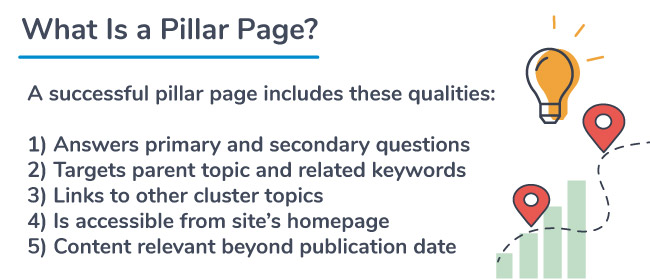What Should a Pillar Page Look Like?
February 18, 2022 •Bret Sexton

Search engine optimization (SEO) keyword research is a foundational piece of creating content that will land your organization at the top of Google's search results. Ahrefs, one of the larger data companies in the search market industry, conducted a study of almost 1 billion web pages. Their study found that roughly 91% of content gets zero traffic from Google.
Everyone wants to be a part of the elusive 9% that receives the traffic from Google. By creating content more efficiently and effectively with a pillar strategy you can be a part of that group. SEO strategies are no longer about stuffing as many keywords into a page as possible. Google understands the difference between filler content and content that is developed with intelligent detail. In this blog we dive into what a pillar page is and a few pillar page examples.
What Is a Pillar Page?
The pillar page of an SEO Pillar strategy is the backbone for every piece that will follow, like support pillars and content clusters/blogs. This page, serving as the informational resource for all other pieces, should be around 3,000 words in length, and be held up by all the supporting blogs and support pillars. This article you’re reading now is an example of a blog that supports a pillar page.
A successful pillar page generally includes these qualities:
- Answers the primary and secondary questions as they relate to the pillar content
- Effectively targets the parent topic and any of its related keywords
- Successfully links to all other cluster topics
- Is accessible from the site's homepage
- Contains content that continues to be relevant past its publication date
A pillar page that has all of these qualities will communicate to Google that your page is an authority of the topic you are writing about and will result in a higher traffic count to your website and business.

How to Write a Pillar Page
If the pillar page is an integral part of creating an effective content strategy, you’re probably thinking that it must be challenging to write. Not necessarily! The process of writing a pillar page can be broken down into a relatively simple process.
- The first step is to decide on a topic for the pillar page. This can be done by analyzing what people in your target market are searching for. Using a service (like DemandJump) can show where your business and your competition rank for relative topics. This information can show you where your focus on content needs to be. It will be an invaluable resource for understanding where your team needs to put extra focus. For example, if your goal is to increase awareness for your personal injury law firm, you can create pillar pages for each of your firm’s focus areas, like “car accidents,” “wrongful death,” or “dog bites.”
- Next, decide on what keywords will be included in the page. To achieve optimal results, aim to include between 15 - 20 keywords for a pillar page.
- Once the topic and keywords are set in place, you are able to begin the writing process.
- Style your keyword questions and phrases in a way that guides the reader and shows the hierarchy of the topics at hand. Style these keywords as “Header 2” where applicable. Making your key talking points into H2 headers not only guides the reader to specific sections of the pillar (making it easier to skin), but it has a positive impact on SEO performance. One way to think about the headers is the H1 header as the title of a book, and the H2 headers as chapters within the book. H3s can be used to break your sections down even further.
- Once you finish writing the pillar, go back through and check how the content of each section funnels back into the title of the piece. Some keywords may pull you off into different directions, but they have to relate back to the core pillar topic.
- After the pillar has been peer-reviewed, it is time to post the pillar and let it do the work for you.
One way to cut through many of the growing pains of creating pillar content is by utilizing one of the many services that an organization like DemandJump offers. DemandJump assembles the world’s data, creates networks of customer touchpoints around any topic or keyword, and tells you exactly what content to write. This way, your content marketing strategy goes from blindly throwing darts at a board to knowing precisely what your target audience is searching for every day. That “content marketing” link we just shared is one of our very own pillars—feel free to check it out for an example of what a pillar page looks like on a website.
While you can start with the smaller cluster topics first, a best practice is to start with the pillar content. This allows your team to better understand what content needs to be included to make the pillar successful.
How Many Pillar Pages Should You Have?
Is one pillar enough? Can you have too many pillars for your content strategy? These are both relevant and common questions that arise during the planning stage of creating a pillar strategy. The number of pillars will come down to personal choice. If you are competing in a highly-populated space, then the more pillars the better. As for the supporting pillars and blogs, we propose a structure of having five or six supporting pillars for every main pillar, with three blogs supporting each support pillars. This means each pillar your team has should be backed by about 20 other pieces of shorter content.
Benefits of Pillar Pages
After all the work is done for creating a pillar page and the supporting content, you may ask if all of this effort truly makes a difference for your business. The short answer is yes. Pillar pages are designed to rank for highly competitive keywords. Utilizing the pillar strategy in conjunction with tools that DemandJump offers will increase your ranking in the search results for your desired topic. Pillar pages not only allow for better content but also create more avenues for educating your audience. In no time, implementing a pillar strategy will have you soaring to the top of Google rankings.
Surge to the Top with DemandJump

Our team understands the importance of SEO, pillar pages, content clusters, and how they can grow a business. Our patented technology and methods we use with clients have shown an average of 229% return on investment within the first 60 days of our kickoff.
If you want to be at the top of Google search results for your intended market, get started with your free trial today!
Featured Articles
Categories
- Attribution Tracking (13)
- Channel Optimization (11)
- Consumer Insights (68)
- Content Marketing (251)
- Data Science (8)
- Digital Marketing (6)
- Digital Transformation (26)
- Enterprise (10)
- Lead Generation (14)
- Market Intelligence (8)
- Marketing Analytics (39)
- Marketing Attribution (57)
- Marketing Management (153)
- Marketing Operations (86)
- Organic Search (222)
- Paid Search (52)
- Pillar-Based Marketing (63)
- Programmatic Advertising (9)
- SaaS Content (14)
- SaaS Marketing (29)
- Search Marketing (111)
- SEO Keyword Research (28)
- SEO Pillar (18)
- SEO Strategy (46)
- SMB (5)
- Website Content (12)


